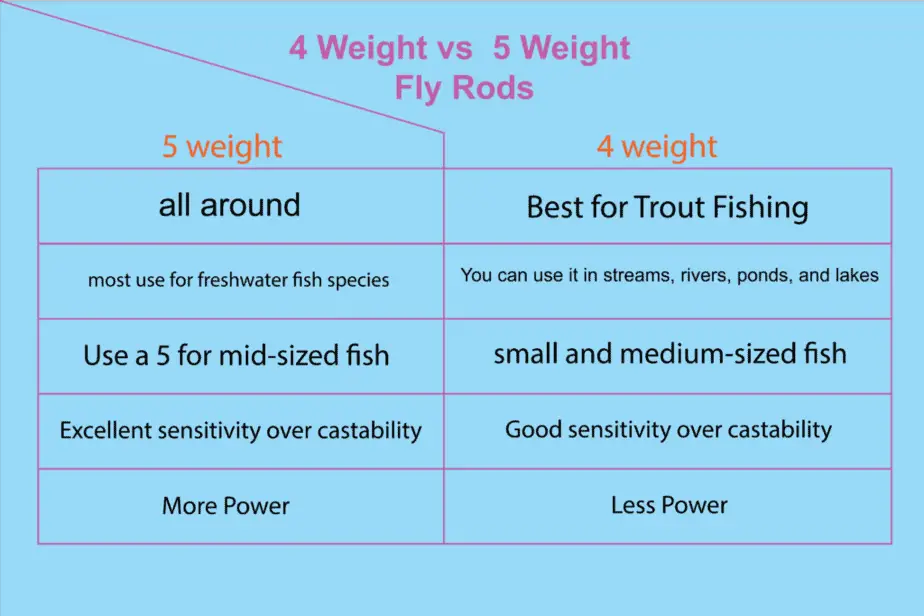Many fly anglers are on the hunt for a new rod. Whether it’s because they want to try a new type of fishing or just looking to upgrade, there are many questions that need answering before you buy. The most common question is “what weight should I go with?”
The answer can be confusing and often depends on what kind of fish you plan on catching, but generally speaking 4 weights are considered better for smaller trout while 5 weights work best for larger trout and other species like bass.
Which one is right for me? We recommend checking out our guide to help figure that out!
A Guide to 5 Weight Fly Rods
Since 5-wt fly rods are the most common, allow me to discuss them first. If you plan to use a 5-weight rod, here are the basic things you should consider before purchasing one.
Budget
There are hundreds of 5-wt fly rods, some of which are relatively affordable, while others are hugely expensive. With so many options, the likelihood of buying a rod that is not worth it is always high. For that reason, take your time and research online to get the best fly rod within your budget.
However, it is crucial to set a realistic budget. Don’t expect to use $15 and get a fly-fishing rod that will last for years. You must be willing to invest at least a hundred dollars to get a high-quality 5-wt fly rod.
Fishing Location
A 5-wt fly rod is considered the best all-around, meaning you can use it in most fishing locations, including lakes, rivers, streams, and ponds. Of late, you can find excellent 5-wt fly-fishing rods for saltwater fishing.
Just ensure to purchase a rod that is recommended for saltwater fishing if you plan to fish in the open sea. Failure to that, your rod may not last as long as it is supposed to last. Also, consider going for a 4-wt rod if you plan to catch smaller species. 4-wt rods are slightly better for light fishing in freshwater.
Cast Action
Typically, fishing rods come with four major cast actions. These actions include fast, slow, medium, and medium-fast. A fast action rod is slightly more sensitive than medium and slow actions, but this sensitivity comes at the expense of casting distance.
This means that the slower-action fishing rods have a better casting distance than the faster action rods. Additionally, most slow-action rods tend to be stiffer and resist snaps better.
For that reason, I usually recommend going for medium or medium-fast action rods. That way, you can balance sensitivity and castability. However, if you plan to catch smaller fish like trout, choose sensitivity over castability.
Number of Pieces
If you are a person who likes traveling around with your fishing gear, you got to consider your rod’s packability. In most cases, the higher the number of pieces, the easier it is to pack and carry a rod. That means a rod that comes in four or two pieces is easier to pack and travel with during hikes.
For that reason, I always consider purchasing a rod with at least two pieces if you travel a lot. You can still travel with your one-piece rod, but it is slightly challenging.
Rod Length Guides
Typically, a 5-weight rod measures about 9 ft. However, it is still possible to find longer or shorter F5-wt rods. A longer rod will improve your casting distance, while a shorter rod will improve the cast’s accuracy.
Longer rods are often more sensitive, but they are not as powerful as shorter rods. Thus, a longer rod is excellent for smaller fish, and shorter rods are excellent for larger fish. Shorter rods also handle the wind better, although they limit your casting distance.
If you fish in a highly vegetated area, I suggest going for a shorter rod for increased accuracy. On the other hand, if you plan to fish in the open sea, I suggest choosing a long rod for increased castability. If you can’t figure out the best length for your needs, choose the standard length, 9 ft. Standard fly-fishing rods always get the job done, and they are beginner-friendly.
Line Weight
Today, line manufacturers have come with a line wt measurement known as grains. An ultralight fishing rod will use the lightest line, measuring from 1-grain, while a heavy rod can use a heavy fly-fishing line measuring up to 14 grains. Remember, for the best castability; you will need to balance the line and rod weight.
Here is how to know which line to use:
- Use fly line weight 1-3 for tiny fish such as trout and panfish.
- Use fly line wt 4 for small and medium-sized fish such as panfish and mid-sized trout.
- Use a 5 for mid-sized fish.
- A line wt-6 is excellent for bass fishing.
- A line wt-7 is also excellent for bass fishing. However, it may be overkill for panfish and some trouts.
- Use a fly line wt-8 and above for larger and stronger fish.
To get the right balance, use almost the same weight for rod, line, and reel. Fly reel w = fly rod wt= fly line wt. Therefore, if you choose a 5-weight fly-fishing rod, choose a 5-wt reel and line. That way, you can be assured of exceptional performance.
Where to Buy 5-weight Fly-fishing Rods
Typically, you can buy a 5-wt fly rod in leading online stores, including Amazon and Fish West. You can also find some in your local fishing stores and retail stores, such as Walmart. Just ensure to consider everything I have mentioned before settling for one.
4-Weight Fly Rods
4-weight fly-fishing rods are excellent and versatile, but they are often underutilized. However, those who use them are aware of just how good they are for nymphing and light fishing. To help you understand why 4-wt rods are as important as 5-wt ones, I will break down several benefits of 4-wt rods. But first, what should you consider when purchasing a 4-wt fly rod?
What to Consider When Purchasing a 4-Weight Fly Rod
You will need to consider the factors we considered for 5-weight fly rods. These factors include:
- Rod length
- Rod construction
- Number of pieces
- Fishing location
- Line weight
- Rod action (Faster action or moderate action)
- Budget
- 4-wt fly lines
You can also consider
- Rod Weights
- Rod Sizes
- Distances ( Shorter distances , Medium distances, and closer distances)
4-weight fly rods are available in online stores such as Amazon, and you can buy one in retail stores such as Walmart. Additionally, you are likely to find a 4-wt fly rod in your local fishing store.
Are 4-Wt Better Than 5-Weight Fly Rods?
Typically, 4-and 5-wt fly rods are like brothers. However, it seems like most people have stigmatized 4-wt rods for nymphing, and they never use them for anything else. This has made many people believe 5-wt rods are much better, but that’s not the case. They are both great in their own ways.
For example, 4-wt fly rods are perfect for trout fishing. This is because about 80 percent of trout’s diet is subsurface and a 4-wt rod is perfect for presenting smaller baits such as nymph.
Additionally, a 4-weight rod can handle just about anything you want to cast as long as they are not too heavy. You can cast flies and other baits with precision. Here are some benefits of 4-weight rods:
Versatility
A 4-wt fly rod is as capable as a 5-wt rod. You can use it in streams, rivers, ponds, and lakes. It is capable of lifting small fish and mid-sized fish with zero problems. In fact, 4-wt rods are more sensitive, so you will feel even the smallest bites.
Lightweight But Can Catch Bigger Stuff
You can still use your 4-wt rods to catch larger stuff such as peacock and largemouth bass hassle-free. A 4-weight fly rod will offer more finesse than a 5-wt, and it still has the power to lift these larger species. Furthermore, you won’t feel too tired if you use a 4-wt fly rod.
Makes Catching Smaller Fish More Enjoyable
If you typically use a 5-wt in an area full of smaller fish, try a 4-weight, and you will see how that change can make smaller fishing much more fun. The lightweight nature and less power of 4-wt rods combine and amplify the thrill of lifting a smaller fish.
How Does 4-Weight Fly Rods Handle Wind?
Some people think that 4-wt rods become useless when there is the wind, but that’s not the case. A 4-wt rod handles wind as well as a 5-weight. It only limits your castability a little but not as much as some anglers think.
What Fish Can I Catch with a 4-Wt?
4-wt rods are typically meant for most freshwater fish species. In most cases, they are used for trout, but you can use them for light-duty bass and panfish. You can even use a 4-wt rod in saltwater for smaller species like snook and bonefish.

4 or. 5-Wt Fly Rod: Wrapping Up
If you are an enthusiastic angler, it will be nice to incorporate several rods that can take different line weights. Having several rods allows you to fine-tune your fishing conditions and enjoy your experience maximumly. Two rods I would suggest to add to your collection is 4-wt and 5-wt rods. They are both excellent for different fishing conditions.






